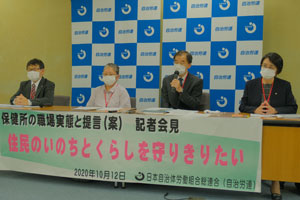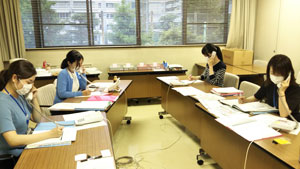Jichiroren exposes excessive workloads at public health centers amid COVID-19 pandemic
Findings of Jichirorenfs survey and proposal are drawing a lot of attention
 The Japan Federation of Prefectural and Municipal Workers’ Unions (Jichiroren), which is affiliated with the National Confederation of Trade Unions (Zenroren), on October 12 held a press conference to release a proposal for improving the public health centers and the working conditions there, to effectively protect the lives and living conditions of local residents from the COVID-19. The proposal is based on an interim report on the “Survey of the workplace in local public health centers under coronavirus outbreak”. It calls for the expansion of PCR testing and the strengthening of the local public health centers to stop the spread of the COVID-19 as part of the effort to protect people’s lives and living conditions.
Two vice presidents, Takayanagi Kyoko and Nagasaka Keizo, and central executive committee member Koizumi Osamu were present at the press conference, attended by public health nurse Yamamoto Tamiko (Chairperson of the Koto Ward Employees’ Union executive committee) and radiological technologist Yanase Kazumi (Member of the Chiba Prefectural Employees Union).
Jichiroren vice president Nagasaka opened the press conference by stressing: “Frontline workers at local public health centers are working from early in the morning till late at night. Some of them have worked 100 overtime a month. Strengthening the functions of the local public health centers is an urgent task.”
He explained the interim report, which includes the following points:
-There are about 500 public health centers in Japan. Jichiroren asked those with union workers to cooperate the survey.
-We got responses from 32 centers in seven prefectures.
-Eighty percent of the respondents said that in April, they experienced shortages of hands and that 40 percent said full-time workers were forced to work overtime without pay.
-In major cities in Tokyo, Kanagawa, and Osaka, which had many confirmed infection cases, some employees worked overtime ranging from 147 hours to 186 hours a month, far more than the 100 hours of “karoshi (death from overtime) line”.
Vice president Takayanagi explained the “Proposal for the Public Health Center”. She said the government has reduced public health administration in disregard of the lessons that the health ministry panel on influenza A(H1N1) viruses drew from the 2009-2010 flu outbreak. The panel stressed the need to improve and expand measures against infectious diseases and called for reinforcing local health centers and public health institutes.
Two COVID-19 frontline workers, Yamamoto Tamiko and Yanase Kazumi, spoke about the harsh working conditions in their workplaces. (For summaries of their remarks, see separate item.)
Reporters asked questions:
“What are the findings of the survey that convince frontline workers?”
“What is the present situation as compared to April when the survey was conducted?”
“The union is calling for more full-time employees to be employed. But don’t you think that hiring more outside support workers or outsourcing jobs to the private sector are the solution?”
Yamamoto responded as follows:
“Workers tend to want to go home as early as possible rather than taking the trouble to do paperwork to apply for overtime pay. They appear to underestimate the problem of forced overtime work without pay. Outside support workers would help us only for a limited time, making it difficult to maintain continuity of jobs. Every time the center accepts outside support staff, it becomes necessary to explain jobs to them from the beginning. Many workers are mentally overburdened and relations between workers are strained. They have only five minutes for lunch. That means they can’t have lunch break. If a local government office sends someone to the public health center, it will affect daily work there, leading degradation in services for the residents. For example, if medical checkup or any other service is suspended, cases of consultation would become latent. If those problems erupt, the office will become overburdened.”
Yanase said:
“The survey shows that half of the public health centers surveyed say they do not collect specimen for testing. This may mean that the number of centers capable of testing has decreased. It may be a result of making light of anti-infectious disease measures after the enactment of the Community Health Act.”
Jichiroren will call on the health ministry to take the necessary steps using its proposal focusing on increasing full-time professional employees, including doctors and public health nurses.
Remarks by public health nurses who are union members (summary)
Yamamoto Tamiko, chairperson of the Koto Ward Employees’ Union
My workplace is the health counseling center in Tokyo’s Koto Ward. Public health nurses superintend particular districts of the ward. They are tasked to comprehend the peculiarities of the districts in charge. They are capable of detecting without fail any signs of outbreak by joining points of confirmed cases and have the ability to prevent cluster infections. They can do it because they are fulltime employees. Support staff from other offices of the municipality, those who are assigned to two posts at the same time, or temporary agency workers cannot have the capacity to continuously watch the sources of infection and are likely to overlook the signs of outbreak. It can take more than half a day to interview persons who have tested positive for the COVID-19. They arrange transportation and hospitalization or self-isolation at hotels for people who have tested positive. They also test people who have had close contacts with COVID-19 infected persons and grasp their health condition in order to ask other municipalities to take care of them. They may also have to ask the workplace for epidemiological study. So, if the center has received reports of 10 cases, we must be prepared for overtime work.
 Some people assert their privacy rights and would not come forward with their health condition. We ask them over again to tell us about their health saying that we want to prevent the coronavirus from spreading more. We perseveringly talk to such persons to build up relationship of confidence with them through small talk so that they finally tell us about their experience. Epidemiological surveys can show the person’s lifestyle and relationship with his or her family. We carry out epidemiological survey by questioning how the person came to be infected. This method was established through the tuberculosis prevalence survey. We conduct an oral survey to know experiences regarding symptoms, their duration, and tendencies of improvement and obtain cases that are not shown as textbook examples. The number of public health centers has been reduced. The number of public health nurses has been reduced. The number of center employees has been reduced. The number of students who aim to become public health nurses has declined. Public health nurses are assigned to a particular area: people with mental problems; mother and child homes, elderly people, abuse, or employees’ health. Fewer public health nurses have experience in dealing with infectious diseases. So, it’s difficult to carry out epidemiological survey amid a pandemic or any other serious disaster and therefore hard to secure residents’ good health. The need now is to ensure that a sufficient number of public health nurses to respond to an emergency like the present pandemic.
Yanase Kazumi, radiological technologist and a member of the Chiba Prefectural Employees Union, Deputy General Secretary of Jichiroren Public Health Union Council
The number of officials in charge of infectious diseases in the public health centers in my prefecture has increased by one this year. But the number of officials in charge of TB decreased by one. So, the total number has been unchanged from last year. The number of COVID-19 cases has not declined. One public health nurse for TB is responding to COVID-19 infections. This means that the number of officials in charge of TB is currently minus two. We are supported by temporary agency workers, but the public health nurse for COVID-19 is busy sending out COVID-19-related documents and doing other jobs. As a result, TB-related work is obstructed.
What we want most is to see an increase in the number of permanent employees. At present, the COVID-19 task force is doing its work in a conference room. We are currently helped by about 20 temporary staff members during the day. They are from other sections as well as from the prefectural government and municipal offices. But after 5 p.m., there are only three or four employees to respond to COVID-19 problems. In July, we petitioned to the health ministry for improving this situation. But ministry officials only said: “It would be difficult to reinforce personnel after the new fiscal year began partly due to central government tax revenue allocated to local governments. Given a lot of money being allocated by the budget, it can be used to hire contingent workers and get private sector help.” Although the use of contingent workers for specialized duties and temporary agency workers has increased, the workloads for the personnel in charge remain almost unchanged. The fact is that the center has difficulty in hiring people with skills and that it is often the case that helping contingent workers is time-consuming. I think that the “Go To” travel and other promotion campaigns, which might lead to the spread of infections, should be reconsidered. I also think that the center’s follow-up of health conditions of infected persons needs to be reviewed. |

